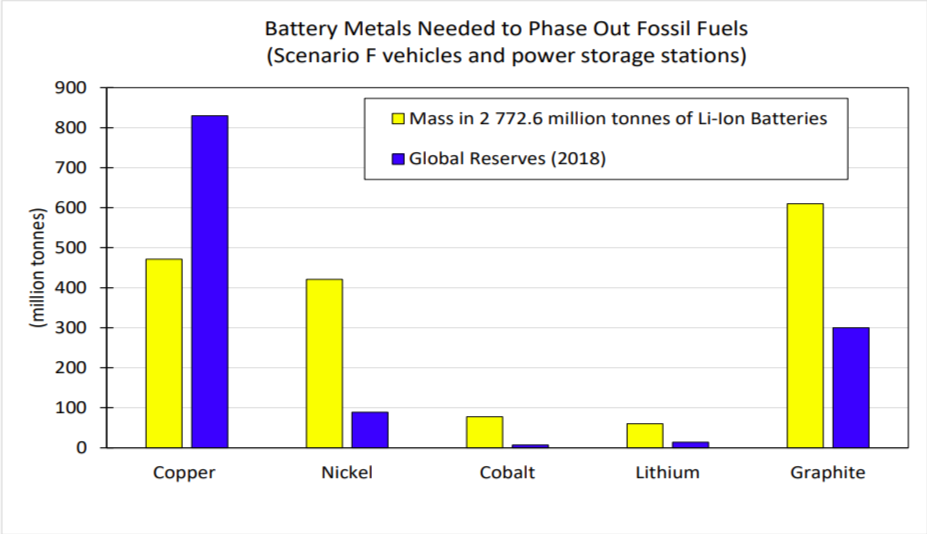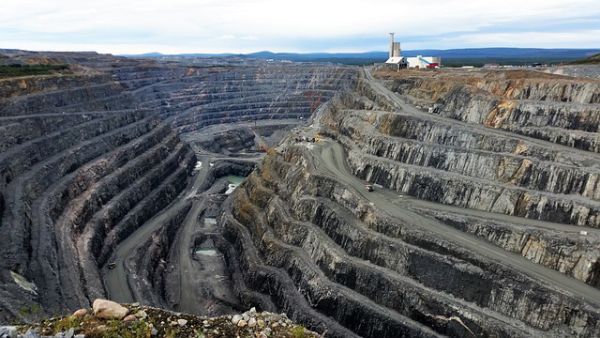These days, we are constantly assured that our leaders and experts will do what’s necessary to promptly eliminate climate change, and open the gate to a clean green renewable utopia. A golden bonus is that spending staggering amounts of money to radically alter the energy-related infrastructure of the entire world will be great for the economy, thrill investors, and create jobs, jobs, jobs!
If we have a fervent blind faith in this miracle, we can relax, keep our lives on autopilot, and shop till we drop.
According to bright green dreams, the answer to all our prayers is to simply abandon fossil energy right away, and power the global economy with wholesome carbon-free renewable electricity. Not everyone agrees. The mainstream media, and many environmental activists, have yet to acknowledge the grumpy skeptics who assert that it’s impossible for today’s industrial civilization, as we know it, to be entirely powered by any flavor of electricity, whether renewable or conventional.
Megan Seibert and William E. Rees explained why. Their report relied heavily on research by Alice Friedemann. Only fossil fuel can generate the intense heat needed to mass produce stuff like steel, concrete, silicon, and so on. It’s also essential for keeping the current transport system on life support (trucks, trains, ships, planes, cars, etc.) — both manufacturing the machines, and fueling their lifetime operation. A team led by Derrick Jensen focused additional attention on bright green hopium.
And now, at long last (sorry!), I shall get to the point of my message. I recently learned about a thousand page report created by the Geological Survey of Finland, a government agency that employs 400 experts. Geologists don’t believe in miracles, they believe in minerals — finite nonrenewable substances, resources that are diminished with each scoop of the power shovels. Every passing year, the reserves get smaller, lower in quality, and more expensive to extract.
The Finnish geologists wondered if seemingly unbelievable miracles were actually possible in reality. They contemplated what modifications would be needed to 2019 technology, in order to create a perfectly sustainable utopia by 2050. The theoretical transition required super-massive global changes to be made in an unimaginably super-speedy manner.
The heroic geologists stumbled upon an important discovery. One minor detail had somehow been overlooked by the clean green renewable dreamers. Their primary focus had been on carbon, climate, positive thinking, and saving the world. It seems there was little or no awareness that the miraculous global transition required huge amounts of specific minerals. Some of the essential minerals were needed in quantities that far exceeded the world’s known resources and reserves. The titanic dream smacked into an iceberg. The geologist’s report focused on three subject areas: transport, electricity generation, and industrial manufacturing.
[A quick vocabulary lesson. “Reserves” are the amount of a resource that can profitably be extracted with existing technology at current prices. “Resources” are the currently known amount of a resource, only a portion of which can be considered reserves.]
The Finnish report explained that the planet-thrashing monster we have created took more than a century to become uncontrollably catastrophic. It was only made possible by guzzling staggering amounts of cheap and abundant oil, an extremely energy dense fuel. Our monster has devoured massive amounts of high quality mineral resources. At the peak of the joyride, folks in wealthy nations enjoyed a fantastic orgy of utterly idiotic waste.
And now, the monster must be ethically euthanized as soon as possible. Energy is no longer cheap. Mineral resources are lower in quality, and far less abundant. Financial systems are loaded with debts, and full of surprises. The planet’s ecosystems are disintegrating in front of our eyes, as the population explosion continues soaring. World leaders are busy butting heads, shooting missiles, and cutting throats. Alas, the Finnish geologists are not giddy with optimism for a quick and easy bright green future.
In the global energy system of 2018, fossil fuels provided 84.7% of the power, nuclear was 10.1%, and renewables were just 4.05% (solar, wind, geothermal, hydro, biofuels, etc.). In other words, nonrenewable energy (fossil + nuke) provided about 95% of the monster’s life force. The geologists focused on energy processes that involved minerals. So, they didn’t mention humankind’s original energy resource, muscle power — it’s not a wildly exciting alternative, but it has a promising future. Imagine everyone wearing bright green MAWA hats (Make America Walk Again).
Obviously, transport systems should rapidly eliminate carbon belching Internal Combustion Engine (ICE) technology. Most green dreamers envision a shift to Electric Vehicle (EV) technology that utilizes rechargeable batteries or fuel cells.
EVs are a very trendy idea today. Battery powered EVs are charged with electricity from the grid. But if the grid is delivering electricity that’s maybe 95% nonrenewable, that’s what their batteries will be charged with. How green is that? Of course, an EV’s frame, fenders, battery, motor, etc., are not made of harmless green fairy dust. Neither are solar panels, wind turbines, or roadways made of asphalt or concrete. Walking has far less impact.
Fuel cell powered EVs use a chemical reaction to generate electricity from hydrogen. During operation, they emit only water. Hydrogen in pure form does not exist in the natural world. Energy is required to separate hydrogen from other compounds. The U.S. Department of Energy says that about 95% of hydrogen is made by processing natural gas (CH4). The Finnish report mentioned an uncomfortable fact: “A potential downside is that much less electricity is harvested from hydrogen in a fuel cell than the electricity required to produce that same volume of hydrogen.”
In 2019, the global transport fleet included about 1.416 billion cars, trucks, buses, and motorcycles, of which 1.39 billion were ICE. These ICE machines need to be sent to the crusher as soon as possible. Is it possible (or ecologically intelligent) to replace them with EVs?
Batteries are a serious challenge for both transport and electricity generation. I’ll chat more about batteries shortly. First, let’s take a peek at electricity generation. It produces energy that is the life force of the grid, the stuff that lights the night, powers appliances, and entrances glowing screen zombies. As mentioned, electricity generation is currently fueled by energy that is maybe 95% nonrenewable, a huge drawback.
Currently, the grid is designed to reliably distribute electricity from large centralized power plants, something like a hub and spokes. A renewable energy grid would have to distribute electricity produced by numerous, smaller, widely dispersed facilities (wind and/or solar). These produce power intermittently, taking naps when the winds go calm, or the sunbeams stop — sometimes for extended periods.
Meanwhile, the end-user demand for electricity constantly rises and falls throughout the day. Today’s power generation infrastructure is carefully designed to react to the frequent ups and downs of demand, by quickly delivering less or more electricity into the grid. If this was not the case, life would have many more technological headaches.
On the other hand, a wind turbine farm pays no attention whatsoever to end-user demand. More wind, more power. No wind, no power. The same is true for solar panel arrays, and the variable inflow of sunbeams. For these systems to work, large scale battery infrastructure is needed to effectively store surplus energy when generation exceeds demand, and then later release stored energy whenever demand exceeds generation. In northern regions, demand zooms higher when winter moves in, so the battery backup buffer would ideally need to store maybe four weeks of electricity — a huge challenge. Nobody knows if this is even possible under real world conditions.
There are two forms of electricity, AC and DC. The grid can only carry AC power. When you plug a gizmo into a wall receptacle, it receives AC. AC cannot be stored — once it is fed into the grid, it will either be used or lost. Surplus AC can be converted to DC, which can be stored in a backup buffer battery, for later use. When demand rises, DC in the battery can be converted to AC, and fed back into the grid. Your cell phone and flashlight have batteries, because they run on DC. Solar panels and wind turbines produce DC, which can be stored in batteries.
And now, the plot thickens. Lithium-ion batteries provide the most efficient storage. To power 1.39 billion EVs, an estimated 282.6 million tons of batteries would be needed. Plus, vastly more battery infrastructure would be needed to provide the storage buffer for the grid — an additional 2.5 billion tons! So, to enable both EVs and grid buffer storage, an estimated 2.78 billion tons of batteries would be needed. “This far exceeds global reserves of nickel, cobalt, lithium, and graphite.” Without adequate storage buffers, “the wind and solar power generation may not be able to be scaled up to the proposed global scope.”
Indeed, the geologists wondered if there are adequate mineral resources to make batteries for just the 1.39 billion EVs. They wrote, “Preliminary calculations show that global reserves, let alone global production, may not be enough to resource the quantity of batteries required.” Oh, and those 1.39 billion EV batteries would have a useful working life of just of 8 to 10 years. And the wind turbines and solar panels also have limited lifespans, 20 to 30 years or so. Everything will need periodic replacement, from now to eternity. For this reason, Alice Friedemann suggests that “renewable” should more accurately be referred to as “rebuildable.” No free lunch.
Mineral resources are neither infinite, easily available, nor cheap. The massive transition to renewables looks more like a frantic short term plastic bandage, rather than an effective, well planned permanent cure. The geologists conclude that a transition to renewable energy seems to be seriously hobbled by the limited availability of nonrenewable minerals.
The recipe for lithium-ion batteries requires five essential minerals: copper, nickel, cobalt, lithium, and graphite. Are there adequate reserves of these minerals to manufacture all those batteries? No, not even close. EV transport would need 1.39 billion batteries. “In theory, there are enough global reserves of copper if they were exclusively used just to produce lithium-ion batteries for just one generation of vehicles.” Reserves of the other four minerals are not adequate to make all of those EV batteries. See the chart on page six of the report’s summary. [LINK]

So, we’ve looked at transport and electricity generation, and their theoretical renewable options. The third focus of the Finnish report was industrial manufacturing. What are the theoretical options for running industrial systems on renewable energy? The geologists can’t think of any. See the chart on page two of the report’s summary.
Simon Michaux authored the Finnish report. He wrote, “In conclusion, this report suggests that replacing the existing fossil fuel powered system (oil, gas, and coal), using renewable technologies, such as solar panels or wind turbines, will not be possible for the entire global human population. There is simply just not enough time, nor resources to do this by the current target set by the world’s most influential nations. What may be required, therefore, is a significant reduction of societal demand for all resources, of all kinds. This implies a very different social contract and a radically different system of governance to what is in place today. Inevitably, this leads to the conclusion that the existing renewable energy sectors and the EV technology systems are merely steppingstones to something else, rather than the final solution. It is recommended that some thought be given to this and what that something else might be.”
Michaux, Simon P., “Assessment of the Extra Capacity Required of Alternative Energy Electrical Power Systems to Completely Replace Fossil Fuels,” Geological Survey of Finland, August 20, 2021.
I did not entirely read the 1,000 page report [LINK]. I did carefully read the fairly understandable eight page summary of the report [LINK].





